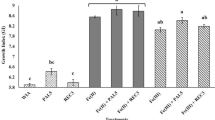Abstract
Metabolites of indolepyruvic acid and indolelactic acid were investigated using 2 systems: a bacterial (pea stem homogenates containing the epiphytic bacteria) and a plant system (pea stem sections under sterile conditions). The products of spontaneous indolepyruvic acid decomposition in aqueous solution and during chromatography were investigated, too.
Biological indolepyruvic acid conversion yields, besides those substance amounts which occur spontaneously, indoleacetic acid, indoleethanol (tryptophol) and (only in the sterile plant system) indoleacetaldehyde. An inhibitor extract from pea stems decreases the indoleacetic acid and increases the indoleethanol and indoleacetaldehyde gain.
Indolelactic acid is not metabolized in the sterile plant sections. Indolelactic acid oxidation by the bacteria-containing homogenate yields indolepyruvic acid and is inhibited by the inhibitor extract.
Abstract
Metabolity kys. indolylpyrohroznové a kys. indolylmléčné byly studovany za pomoci 2 systémů: bakteriálního (homogenáty stonků hrachu obsahujících epifytické bakterie) a rostlinného (sekce stonků hrachu vypestovaného za sterilních podmínek). V laboratorních podmínkach byly rovnež sledovány produkty spontanního rozkladu kyseliny indolylpyrohroznové ve vedném roztoku a v průběhu chromatografie.
Biologická přeměna kys. indolylpyrohroznové poskytuje vedle látek, které se tvoří spontánně, kyselinu indolyloctovou, indolylethanol (tryptofol) a (jen ve sterilním prostředí) indolylacetaldehyd. Extrakt inhibitoru ze stonků hrachu snižuje kys. indolyloctovou a zvyšuje tvorbu indolylethanolu a indolylacetaldehydu. Kys. indolylmléčná není metabolizována ve sterilních sekcích rostlin. Oxydací kys. indolylmléčné homogenátem obsahujícím bakterie se tvoří kys. indolylpyrohroznová; tato oxydace je inhibována extraktem s nativním inhibitorem.
Similar content being viewed by others
References
Ballin, G.: Aktivität von Indol-3-milchsäure in biologischen Tests.—Flora, A158: 407–412, 1967.
Bentley, J. A., Farrar, K. R., Housley, S., Smith, G. F., Taylor, W. C.: Some chemical and physiological properties of 3-indolylypyruvic acid.—Biochem. J.64: 44–49, 1956.
Glombitza, K. W., Hartmann, T.: Der Tryptophanabban beiEndomycopsis vernalis und anderen Hefen.—Planta69: 135–149, 1969.
Gordon, S. A.: The biogenesis of natural auxin.—In:Wain, R. L., Wightman, F. (ed.): The Chemistry and Mode of Action of Plant Growth Substances, London, pp. 65–75, 1956.
Gordon, S. A.: The biogenesis of auxin.—In:Ruhland, W. (ed.): Encyclopedia of Plant Physiol. Vol. 14, Springer Verlag, Berlin, pp. 620–646, 1961.
Hartmann, T., Glombitza, K. W.: Der Tryptophan-Abbau beiRhizobium leguminosarum. —Arch. Mikrobiol.56: 1–8, 1967.
Kaper, J. M., Gebhard, O., Van Den Berg, C. J., Veldstra, H.: Studies on indolepyruvic acid. I. Synthesis and paper chromatography.—Arch. Biochem. Biophys,103: 469–474, 1963.
Kaper, J. M., Veldstra, H.: On the metabolism of tryptophan byAgrobacterium tumefaciens. —Biochim. biophys. Acta30: 401–420, 1958.
Libbert, E., Brunn, K.: Nachweis von Indol-3-brenztraubensäure und Indol-3-äthanol (Tryptophol) bei der enzymatischen Auxinbildung aus Tryptophan in vivo..—Naturwiss.48: 741, 1961.
Libbert, E., Drawert, A., Schröder, R.: Pathways of IAA production from tryptophan by plants and by their epiphytic bacteria: a comparison. I. IAA formation by sterile pea sectionsin vivo as influenced by IAA oxidase inhibitors and by transaminase coenzyme. —Physiol. Plant.22, 1217–1225, 1969.
Libbert, E., Fischer, E., Drawert, A., Schröder, R.: Pathways of IAA production from tryptophan by plants and their by epiphytic bacteria: a comparison. II. Establishment of the tryptophan metabolites, effects of a native inhibitor..—Physiol. Plant.23: 278–286 1970a.
Libbert, E., Schröder, R., Drawert, A., Fischer, E.: Pathways of IAA production from tryptophan by plants and by their epiphytic bacteria: a comparison. III. Metabolism of tryptamine, indoleacetaldehyde, indoleethanol and indoleacetamide, effects of a native inhibitor.—Physiol. Plant.23: 287–293 1970b.
Melchior, G. H.: Über den Abbau von Indolderivaten. I. Photolyse durch ultraviolettes Licht. —Planta50: 262–290, 1957.
Rigaud, M. J.: Synthèse d'acide indolyl-3-lactique et de tryptophol parRhyzobium cultivé en présence de tryptophane.—C. R. Acad. Sci. (Paris)262: 100–102, 1966.
Schwarz, K.: Separation of enol and keto tautomers of aromatic pyruvic acids by paper chromatography. —Arch. Biochem. Biophys.92: 168–175, 1961.
Schwarz, K., Bitancourt, A. A.: A decomposicao espontanea de alguns derivados indolicos. II. Acido indolpiruvico.—Arqu. Inst. Biol. (Sao Paulo)24: 183–197, 1957.
Schwarz, K., Bitancourt, A. A.: Further evidence of tautomerism in chromatograms of indolyl-3-pyruvic acid.—Biochem. J.75: 182–187, 1960.
Wightman, F.: Pathways of tryptophan metabolism in tomato plants.—(Coll. intern. du C.N.R.S. No. 123: Régulateurs Naturels de la Croissance Végétale, Gif-sur-Yvette 1963) Edit. du C.N.R.S., Paris, pp. 191–212, 1964.
Wightman, F., Cohen, D.: Intermediary steps in the enzymatic conversion of tryptophan to IAA in cell-free systems from higher plants.—In:Wightman, F., Setterfield, G. (ed.): Biochem. and Physiol. of Plant Growth Substances, The Runge Press, Ottawa, pp. 273–288, 1968.
Author information
Authors and Affiliations
Additional information
Address: 25 Rostock, Doberaner Strasse 143, DDR.
Rights and permissions
About this article
Cite this article
Libbert, E., Brunn, K., Drawert, A. et al. Pathways of IAA production from tryptophan by plants and by their epiphytic bacteria: Metabolism of indolepyruvic acid and indolelactic acid. Biol Plant 12, 246–255 (1970). https://doi.org/10.1007/BF02920809
Received:
Published:
Issue Date:
DOI: https://doi.org/10.1007/BF02920809



